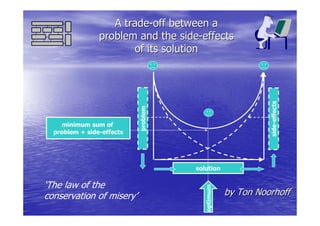A Trade Off
- 1. A trade-off between a problem and the side-effects of its solution side-effects problem minimum sum of problem + side-effects solution °ÆThe law of the optimum conservation of misery°Ø by Ton Noorhoff
- 2. A trade-off between a problem and the side-effects of its solution ? Concept by Ton Noorhoff ®C We often notice that gradual application of a solution does decrease the problem, but also causes increasing side- effects that can become side-effects problem worse than the problem. minimum sum of problem + side-effects ®C This explains the existence of an partial solution that minimizes the sum of solution problem + side-effects. That °ÆThe law of the conservation optimum of misery°Ø is the optimum solution
- 3. A trade-off between a problem and the side-effects of its solution ? Examples by Ton Noorhoff ®C Quality management ? Problem = (Cost of) insufficient quality ? Solution = Quality Management side-effects ? Side-effects = Cost of Quality problem Management minimum sum of problem + side-effects ®C Security management ®C A quality of life ? Problem = (Cost of) solution criminality °ÆThe law of the conservation optimum of misery°Ø ? Solution = Crime-fighting ? Side-effects = Cost of crime- fighting


